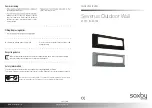
WALL ANCHOR GUIDELINE
WALL ANCHOR GUIDELINE
www.jaypro.com / (800) 243-0533 / 976 Hartford Tpke, Waterford, CT 06385 USA
SUBJECT TO CHANGES IN DESIGN AND MANUFACTURING
© COPYRIGHT 2022 JAYPRO SPORTS, LLC. ALL RIGHTS RESERVED
Sheet 2 of 10
INNOVATION, PERFORMANCE AND COMMITMENT SINCE 1953
OVERVIEW / GENERAL NOTES:
1. Consult an Architect or Structural Engineer to ensure wall structure is sufficent, additional blocking is added (if applicable) and to ensure
the proper anchors are used to attach the permanent equipment to the wall. Failure to do so may result in damage, injury and / or death.
2. Jaypro Sports is not responsible for the wall structure or determining if the wall structure can support the backstop. Wall structure must
be capable of supporting the entire load of the backstop and accessories, as well as the additional loading caused by an individual slam
dunking and hanging on the rim.
3. It can be argued that the wall anchor is the most critical component of the wall mounted backstop system. All of the weight of the unit,
as well as the load introduced through play and use of the equipment, ultimately must be supported by the wall anchors. Preparation of the
wall, drilling of the holes in the proper location and depth, and most importantly correct selection of the type of anchor are all critical steps
in the installation process.
4. All wall anchors are supplied by others. Select the proper wall anchors for the given wall conditions. All wall anchors should be a
minimum of 1/2" diameter. When possible, thru-bolting is preferred. If possible, thru-bolt at least two times per stringer, in addition to
additional anchors. Avoid putting anchors in line with each other, which would promote wood splitting.
5. This manual provides general guidance showing preferred anchor pattern for various sizes of wood planks. These are intended only as
a general guide. Field conditions and obstructions, mortar joints and CMU web/cavity locations, sound proof blocking, all these present
situations which must be handled in the best way possible to ensure a proper wall mounted installation.
6. For wall mounted backstops with chain supports, cable directional pulleys, winches, and / or safety straps, it is highly recommended that
wood stringers be secured with thru-bolts. The majority of the load of the backstops is transferred directly to these points. In the case of
low ceilings or roof structure, the top chain attachment points may be made directly to building steel. This is not an option for side folding
units, only stationary and fold-up models. Note that with the fold-up style you may be limited in the amount the unit can fold if roof structure
is used.
7. Use a minimum of 4 anchors for each manual or electric winch attachment point. Consult drawings in this manual for specific details on
the two standard winch assemblies.
8. Remove any sheetrock/gypsum boards or other non-structural materials from area directly behind all wood planks. If necessary,
replace sheetrock with a plywood spacer / shim to provide a flush mounting surface on a finished wall. Failure to do so may result in
improper anchoring or anchors loosening over time.
9. It is not recommended that any wood stringers are mounted to the top two runs of CMU block, as these upper rows often are not
structurally sound for attachment. If necessary, consult with the Structual Engineer, Architect, or General Contractor to confirm CMU is
sound for anchoring.
10. Acoustical block, or "sound block", is the worst possible masonry type for wall mounted backstops. The block facing is textured, and
has vertical slots every few inches. Acoustical block must be filled solid at all attachment areas or failure is likely to occur.
11. The following pages lists three of the most common wall anchors. Before drilling a single hole you must verify the type of wall you will
be installing against and then procure the necessary type and quantity of anchor to guarantee a successful installation. Immediately below
is a table listing acceptable anchor types for given wall compositions.
12. Over the course of time, wall anchors and bolted connections may loosen as a result of building vibrations or vibrations caused during
play. Periodic inspection and rework is strongly advised to tighten hardware and return the equipment to the original level of safety.
Wall Construction
Recommended Anchor
All Wall Types
CMU (Filled / Solid)
CMU (Hollow)
Pre-Cast, 4" or Thicker
Thru-Bolting Recommended
Hilti KWIK Bolt 3
1/2" Min Tumble Toggle
Double Expansion Shield
Hilti KWIK Bolt 3
Wood / Metal Studded Wall
(Additional Blocking Required - By Others)
Thru-Bolts or Wood Lag Screws








































